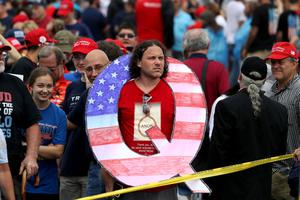President Trump and PM Netanyahu Propose Two-State Plan for Israel-Palestine Peace
Prime Minister Netanyahu, who was in Washington on Tuesday for the unveiling of the plan, said that it “strikes the right balance where others have failed.”

WASHINGTON, D.C. — President Donald Trump and Israeli Prime Minister Benjamin Netanyahu proposed a new peace plan for the Middle East on Tuesday. The plan includes an independent Palestinian state with a capital in East Jerusalem.
President Trump said Jan. 28 that the plan offers a “win-win opportunity for both sides” and a “realistic two-state solution that resolves the risk of Palestinian statehood to Israel’s security.”
“This is the first time Israel has authorized the release of a conceptual map, illustrating the territorial consequences it’s willing to make for the cause of peace,” said President Trump. “And they’ve gone a long way. This is an unprecedented and highly significant development.”
Prime Minister Netanyahu, who was in Washington on Tuesday for the unveiling of the plan, also used the term “realistic” when describing the proposal and said that it “strikes the right balance where others have failed.”
Despite optimism from the two leaders, the proposal was not welcomed by the Palestinian Authority. President Mahmoud Abbas said in a statement on Tuesday evening that the proposal “will not pass.” Protests erupted in Gaza following the announcement of the plan.
Under the terms of the proposal, the Palestinian state would have a capital city called Al-Quds, the Arabic name for Jerusalem, which would include parts of East Jerusalem. Despite this, Trump insisted that Jerusalem would also remain “Israel’s undivided--very important--undivided capital.” The United States moved their embassy in Israel to Jerusalem in 2017.
Under the plan, none of Jerusalem’s Old City or territory within the current security wall would be ceded to the Palestinian state. The agreement also preserves the status quo policy regarding control of various religious sites, including the site of the Temple Mount and Al Aqsa Mosque, and, under the proposal, Muslims would still have access to the site.
The plan also proposes the construction of a “West Bank-Gaza Tunnel” to connect the two halves of the new state, and that a third of the Gaza Strip be designated as a “high-tech manufacturing industrial zone.”
President Trump claimed Tuesday that the plan would “more than double Palestinian territory” without causing additional displacement for either Israelis or Palestinians. The plan includes provision for a “land freeze” over the next four years to maintain the borders of the proposed Palestinian state.
As part of the plan, President Trump also pledged $50 billion towards the Palestinian state for job creation and poverty reduction. President Trump said that if Abbas and the Palestinian Authority “choose the path to peace,” that the United States and other countries “will be there, we will be there to help you in so many different ways.”
After the announcement of the plan, President Trump sent out a variety of tweets in English, Hebrew, and Arabic championing the proposal.
“I will always stand with the State of Israel and the Jewish people. I strongly support their safety and security and their right to live in their historic homeland. It's time for peace!” the president tweeted in English and Hebrew.
“This is what a future State of Palestine can look like, with a capital in parts of East Jerusalem,” President Trump tweeted in Arabic and English. Both tweets included a map of the proposed two states.
Parts of the proposed plan would seem to be in line with the Holy See’s stated preferences for a lasting peace in the Holy Land.
Monsignor Fredrik Hansen, chargé d’affaires of the Permanent Observer Mission of the Holy See, told the UN Security Council on Jan. 22 that Pope Francis continues to advocate for a two-state solution and a status quo policy in Jerusalem for shared religious sites.
“Indeed, the appeal to maintain the status quo of the holy sites of Jerusalem, dear to Jews, Christians and Muslims in virtue of their religion and important for the cultural heritage of the whole human family, is one that has been repeatedly made,” said Monsignor Hansen.
Pope Francis, Monsignor Hansen said, wishes for Jerusalem to live out “its vocation as a city of peace,” which can be a symbolic location of peace and encounter, with respect between religions and continued dialogue.

















